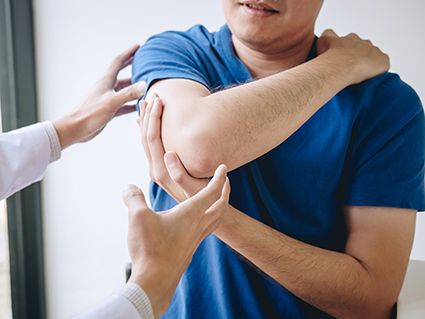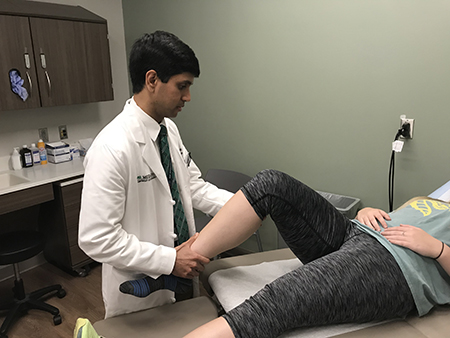 UAB orthopaedic surgeons report that the cost of orthobiologics, promising but not fully proven therapies, can vary widely across the nation. The use of orthobiologics is a hot trend in orthopaedics, but new research from the University of Alabama at Birmingham shows wide variability in cost for these therapies. The UAB study, published in Sports Health, Oct. 2019, looked at two orthobiologic therapies; platelet-rich plasma injections and stem cell injections, and found dramatic cost variability ranging from a few hundred dollars to as much as $12,000. That is troublesome, say UAB researchers, especially for therapies that are yet to be conclusively proven effective.
UAB orthopaedic surgeons report that the cost of orthobiologics, promising but not fully proven therapies, can vary widely across the nation. The use of orthobiologics is a hot trend in orthopaedics, but new research from the University of Alabama at Birmingham shows wide variability in cost for these therapies. The UAB study, published in Sports Health, Oct. 2019, looked at two orthobiologic therapies; platelet-rich plasma injections and stem cell injections, and found dramatic cost variability ranging from a few hundred dollars to as much as $12,000. That is troublesome, say UAB researchers, especially for therapies that are yet to be conclusively proven effective.
“Research into the efficacy of these therapies is mixed at best,” said Amit Momaya, M.D., assistant professor in the Department of Orthopaedic Surgery at the UAB School of Medicine and the study’s first author. “Some studies show benefit, others don’t. More research is needed to definitively determine their effectiveness, but in the meantime consumers can find themselves paying a lot of money for something that may — or may not — work.”
Orthobiologics such as platelet-rich plasma injections and stem cell injections have been suggested to improve healing and manage pain following orthopaedic injury. They are autologous therapies, meaning they are derived from the patient’s own blood or cells. Because they are autologous, their use is not highly regulated by the government and there is minimal oversight from the public health community.
“Platelet-rich plasma injections are FDA approved for bone grafts, but not for other uses for which they are now marketed,” said Brent Ponce, M.D., professor of orthopaedics and senior author of the paper. “As physicians, we think there is cause for concern when an experimental therapy can cost hundreds of dollars at one health care provider and thousands at another. There is a tremendous need for consumer education and for more regulatory oversight.”
Momaya and Ponce’s team surveyed 1,345 orthopaedic sports medicine practices around the United States, asking if orthobiologics were offered and at what cost. Roughly two thirds of the responding practices offered one or both of the therapies. In general, costs were higher in affluent areas of larger cities. Geographically, costs were higher in the western regions of the country and lower in the south. Large orthopaedic practices were more likely to have higher prices than smaller practices.
The mean cost of the platelet-rich plasma injection was $707, with a range of $175 to $4,973. Stem cell injections had a mean cost of $2,728, ranging from $300 to $12,000. In most cases, insurance does not cover the cost of the injections.
“The differences in cost are significant and you could certainly ask if these differences are unethical,” Momaya said. “We understand that there are patients willing to pay for a therapy they hope will stave off major surgery such as joint replacement, but we are concerned whether patients are getting the facts about what these therapies can and cannot do. Do they have accurate expectations? Just because a desperate patient has the means to pay thousands of dollars, is it right for medical professionals to charge that much?”
Full disclosure: UAB’s Department of Orthopaedics offers platelet-rich plasma injections and stem cell injections for some conditions. UAB’s charges are at the low end of the cost range; platelet-rich plasma injections are $350, for example. UAB physicians who offer orthobiologics are following their patients over time to learn more about their effectiveness.
 Drs. Momaya (pictured) and Ponce say orthobiologic therapies are promising, but that the cost for the treatments varies widely across the nation. “There is reason to think that orthobiologics might be beneficial and it is incumbent on the medical profession to study their effectiveness and determine how best to utilize these therapies,” Ponce said. “As that process continues, consumers need to be better educated. We fear there is misleading information circulating about orthobiologics, which helps create an environment with widely fluctuating costs.”
Drs. Momaya (pictured) and Ponce say orthobiologic therapies are promising, but that the cost for the treatments varies widely across the nation. “There is reason to think that orthobiologics might be beneficial and it is incumbent on the medical profession to study their effectiveness and determine how best to utilize these therapies,” Ponce said. “As that process continues, consumers need to be better educated. We fear there is misleading information circulating about orthobiologics, which helps create an environment with widely fluctuating costs.”
Ponce and Momaya suggest that patients interested in orthobiologics should shop around. They recommend using a directory of sports medicine surgeons from the American Orthopaedic Society for Sports Medicine to find appropriate medical professionals. They further suggest consider enrolling in a clinical trial or at least work with the medical team to follow and track outcomes.
“We are not against the use of orthobiologics,” Momaya said. “We use them ourselves as we work to understand which conditions and which patients are most likely to benefit from these therapies. But until we can say with confidence that these are effective, we have to urge patients to use caution and get as much information as possible about effectiveness and cost before pursuing orthobiologic therapy.”
Co-authors of the study along with Momaya and Ponce are Eugene Brabston, M.D., Andrew McGee, Alexander Dornbrowsky, Raymond Waldrop and Jun Kit He from UAB; Alan Wild, Alabama College of Osteopathic Medicine and Naqeeb Faroqui, Mercer University School of Medicine.